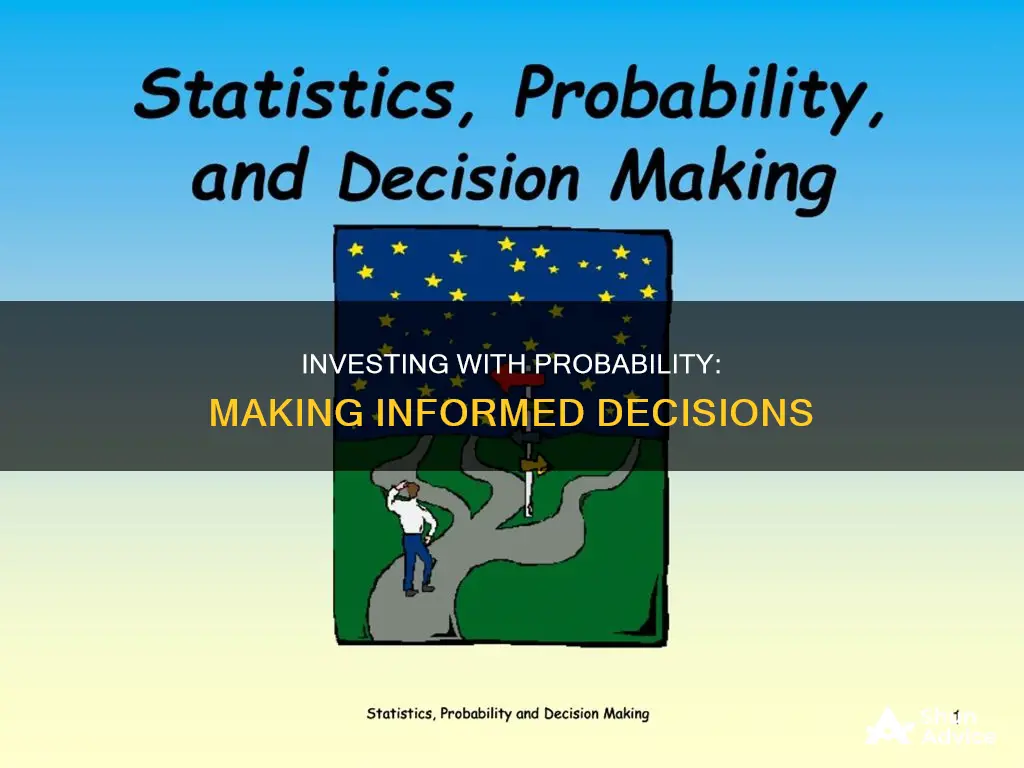
Probability is a crucial concept in investing, providing a framework for decision-making and understanding risk and reward. While investing is inherently uncertain, probabilities allow investors to assess and manage expectations, making informed choices. This is known as probability theory, and it's key to long-term success. For example, while short-term stock market movements are unpredictable, over longer periods, positive returns are more likely. Investors use probability distributions to estimate asset returns and manage risk, acknowledging that outcomes are uncertain and based on subjective probabilities. Understanding probability helps investors avoid common pitfalls, such as mistaking a string of profits or losses for skill or lack thereof. It also aids in evaluating mutual funds or hedge funds by assessing whether returns are likely to continue or are simply random events. Ultimately, probability theory helps investors make disciplined decisions, improving their chances of long-term financial success.
| Characteristics | Values |
|---|---|
| Purpose | To anticipate returns on assets such as stocks over time and to hedge risk |
| Application | Used to create cumulative distribution functions (CDFs) that add up the probability of occurrences cumulatively |
| Users | Academics, financial analysts, and fund managers |
| Probability Distribution Types | Normal, chi-square, binomial, and Poisson distribution |
| Use Cases | To estimate the returns of an investment asset and to determine the possibility of loss events |
| Probability Range | Between 0 (impossible) and 1 (certain) or 0% and 100% |
| Expected Value Calculation | Probability of Receiving Value x Value Received |
What You'll Learn
- Probability distributions are used to anticipate returns on assets
- Probability theory is used to predict short-term stock market movements
- Probability is used to determine the possibility of loss
- Probabilities can be used to gauge whether returns are likely to continue
- Probability theory can be used to make better investment decisions

Probability distributions are used to anticipate returns on assets
Probability distributions are an essential tool for investors, helping them to anticipate the returns on assets such as stocks over time and to hedge their risk. A probability distribution is a statistical function that describes all the possible values and their likelihoods that a random variable can take within a given range. The range is bounded by the minimum and maximum possible values. The possible value is plotted on the probability distribution based on factors such as the distribution's mean, standard deviation, skewness, and kurtosis.
Investors use probability distributions to make informed decisions about their investments. By understanding the expected outcomes of various assets, investors can assess the potential returns and risks associated with those investments. This information helps investors make more strategic choices, manage their portfolios, and optimise their investment strategies.
The normal distribution, or bell curve, is one of the most commonly used probability distributions. It is characterised by its mean and standard deviation, exhibiting symmetry without skewness. Approximately 68% of the data in a normal distribution falls within one standard deviation of the mean, with 95% falling within two standard deviations.
Other types of probability distributions include the binomial distribution, which evaluates the probability of an event occurring over a given number of trials, and the Poisson distribution, which models the number of events occurring within a fixed interval, assuming they are independent of each other.
While stock returns are often assumed to follow a normal distribution, they tend to exhibit kurtosis, with larger negative and positive returns than predicted by a normal distribution. This leads to a log-normal distribution for stock returns, where stock prices are bounded by zero but have unlimited upside potential.
Probability distributions are also used in risk management to assess the likelihood and magnitude of potential losses within an investment portfolio. By analysing historical returns, investors can make informed decisions about their risk tolerance and adjust their investment strategies accordingly.
Robo-Advisers: Investment Advisers' Future or Fad?
You may want to see also

Probability theory is used to predict short-term stock market movements
Probability theory is a framework that investors use to predict short-term stock market movements. It is a way to assess and manage expectations about risk and reward. By analysing all relevant information, investors can adjust the probabilities and payouts they assign to various outcomes.
The two basic principles of probability are: a given probability must be between 0 (impossible) and 1 (certain), or between 0% and 100% in percentage terms; and all possible outcomes must have probabilities that add up to 1 (or 100%). For example, when flipping a coin, the probability of landing heads-up is 50%, and the probability of landing tails-up is 50%. However, it is possible, albeit unlikely, for a coin to land on its edge. Excluding this possibility, the only outcomes are heads and tails, which must add up to 100%. If the possibility of the coin landing on its edge is included, the probabilities for heads and tails would be adjusted to 49.5%, with a 1% chance of the coin landing on its edge.
In the context of investing, probability theory can be applied to a simple example. If 100 people are asked to predict the outcome of a single coin flip, the probability is that 50% will predict correctly and 50% will be incorrect. If the coin is flipped twice, the odds are that only 25% of the predictors will guess both flips correctly. With each additional coin flip, the accuracy of the predictions will decrease. After 10 coin flips, the odds are that only 1 out of 1000 will have predicted every flip correctly.
This concept can be applied to the stock market, which is much more complex. Studies have shown that short-term returns in the stock market are random, but with a positive bias. This means that there will be more positive outcomes than negative ones over time. While it is not possible to predict the stock market's movements on a daily, weekly, monthly, or yearly basis, there will be a few prognosticators who can successfully predict short-term movements over several time periods. As a result, people begin to follow their advice, and their confidence in their abilities grows, leading to larger bets. However, inevitably, the odds catch up with the prognosticator, and incorrect guesses can cause significant harm.
Probability distributions are also used in investing to anticipate returns on assets and hedge risks. A probability distribution is a statistical function that describes all the possible values and their likelihoods that a random variable can take within a given range. It is defined by factors such as the mean, standard deviation, skewness, and kurtosis. The normal distribution or bell curve is commonly used in finance and investing.
In summary, probability theory provides a framework for investors to make informed decisions about short-term stock market movements by assessing and managing their expectations of risk and reward. While it is important to recognise that investing involves subjective probabilities rather than exact ones, understanding probability theory can help investors make more disciplined and successful investment decisions over the long run.
Understanding Net Cash Flow: Does It Include Investments?
You may want to see also

Probability is used to determine the possibility of loss
Probability is a powerful tool in investing, providing valuable insights into potential risks and returns. One of its critical applications is in determining the possibility of loss, a fundamental aspect of investment decision-making. Here's how probability helps investors assess and manage the potential for losses:
Understanding Loss Probability
Probability theory enables investors to assess the likelihood of losses by analysing historical data and market trends. For example, by examining the history of a stock's returns over different time intervals, investors can gain insights into the probability of future losses. This analysis considers factors such as the distribution's mean, standard deviation, skewness, and kurtosis, allowing for a more nuanced understanding of potential losses.
Risk Management and Hedging
Probability distributions play a crucial role in risk management. They help investors evaluate the probability and magnitude of losses their portfolio might incur based on historical returns. One popular metric in this regard is Value at Risk (VaR), which calculates the minimum loss expected within a given probability and time frame. VaR helps investors make informed decisions by providing a quantitative estimate of potential losses.
Long-Term Perspective
Probability theory emphasises the importance of long-term thinking in investing. While short-term market movements may seem unpredictable, probability theory suggests that, over time, positive outcomes are more likely than negative ones. This perspective encourages investors to focus on long-term investment strategies, reducing the impact of short-term losses and increasing the likelihood of overall positive returns.
Informed Decision-Making
By understanding probabilities, investors can make more informed decisions. They can assess whether returns are likely to continue or are simply due to random events. This distinction is crucial in determining the sustainability of investment strategies and avoiding overconfidence in short-term gains. Probability theory encourages a disciplined approach, considering multiple factors and adjusting expectations about risk and reward.
Subjective Probabilities
In investing, it's important to recognise that probabilities are often subjective. They are based on an individual's knowledge, experience, and interpretation of market data. As such, investors should continually educate themselves and refine their understanding of market dynamics to improve the accuracy of their probability assessments. This process helps in making more informed decisions and managing risk effectively.
In summary, probability theory is a valuable tool for investors seeking to understand and manage the possibility of loss. It provides a framework for analysing historical data, making informed decisions, and adopting a long-term perspective. By applying probability concepts, investors can better navigate the inherent uncertainties of the market and make more strategic choices to mitigate potential losses.
Should I Withdraw My Vanguard Investments?
You may want to see also

Probabilities can be used to gauge whether returns are likely to continue
Probability is a useful tool for investors to gauge whether returns are likely to continue or if they were simply the result of a random event.
Firstly, it is important to note that short-term returns in the stock market are random, albeit with a positive bias. This means that there will be more positive outcomes than negative ones over time. However, it is impossible to predict the market on a daily, weekly, monthly, or even yearly basis. This is where probabilities come in.
Probabilities can be used to determine whether superior trading is due to luck or skill. This often requires many years of observation, especially for longer-term investment strategies. For example, if an investor has made three profitable trades in a row, it is easy to assume that skill is involved. However, this could simply be a result of random probabilities, as each trade has a 50% chance of being profitable. To determine whether this is due to skill, an investor would need to analyse the outcomes of their trades over a longer period of time.
Additionally, investors can use historical investment returns to make reasonable guesses about how different asset classes will perform in the future. For example, while it is difficult to predict stock returns on a yearly basis, we know that over the course of several decades, stock returns tend to be positive. By looking at historical data, investors can make more informed decisions about the likelihood of returns continuing.
Furthermore, probability distributions can be used to anticipate returns on assets such as stocks and to hedge risk. A probability distribution is a statistical function that describes all the possible values and likelihoods that a random variable can take within a given range. Academics, financial analysts, and fund managers can use probability distributions to evaluate the expected returns that a particular stock may yield in the future.
In conclusion, while probabilities cannot predict the future, they can be a useful tool for investors to gauge whether returns are likely to continue. By understanding probabilities, investors can make more informed decisions and avoid common pitfalls caused by randomness or short-term trends.
HSA Investment or Cash: Which Option is Better?
You may want to see also

Probability theory can be used to make better investment decisions
Probability theory is a powerful tool that can guide investors in making more informed and strategic decisions. By analysing various factors and assigning probabilities to different outcomes, investors can improve their chances of success and manage their expectations about risk and reward. While the stock market is notoriously unpredictable in the short term, probability theory can help investors make more disciplined choices and improve their long-term financial outcomes.
Understanding the Basics of Probability
At its core, probability theory assigns numerical values to the likelihood of an event occurring. These values range from 0 (impossible) to 1 (certain), or from 0% to 100% in percentage terms. When considering all possible outcomes, these probabilities must add up to 1 or 100%. For example, in a coin toss, the probability of landing heads or tails is typically assumed to be 50% each, excluding the unlikely possibility of the coin landing on its edge.
Applying Probability to Investing
Investors can use probability theory to assess the expected value of their investments. The expected value is calculated by multiplying the probability of receiving a certain outcome by the value of that outcome. For instance, if there is a 60% chance of winning $2,000, the expected value is $1,200. This framework helps investors weigh their options and make more informed decisions.
Evaluating Risk and Reward
Probability theory also plays a crucial role in managing risk and reward. While investing inherently involves uncertainty, understanding probabilities can help investors make disciplined choices that favour their long-term success. Similar to casino games, investing is not about making a single brilliant decision but about consistently making choices that keep the odds in your favour. Over time, these disciplined decisions can lead to positive outcomes.
Historical Data and Probabilities
Historical investment data can be a valuable source of information for investors. By analysing past performance, investors can make educated guesses about how different asset classes might behave in the future. For example, while individual stocks may fluctuate, historical data suggests that stock returns tend to be positive over several decades. This knowledge can inform investment strategies and help investors manage their expectations.
The Impact of Trends
Trends in the market can also influence investment decisions. Stock prices tend to move in specific directions over time, and this can skew the probability curve. By recognising and analysing these trends, investors can identify profitable opportunities even in short time frames. However, it is important to remember that past performance does not guarantee future results, and a disciplined approach to investing is always essential.
Understanding Cash Equivalents: A Guide to Investing Wisely
You may want to see also







